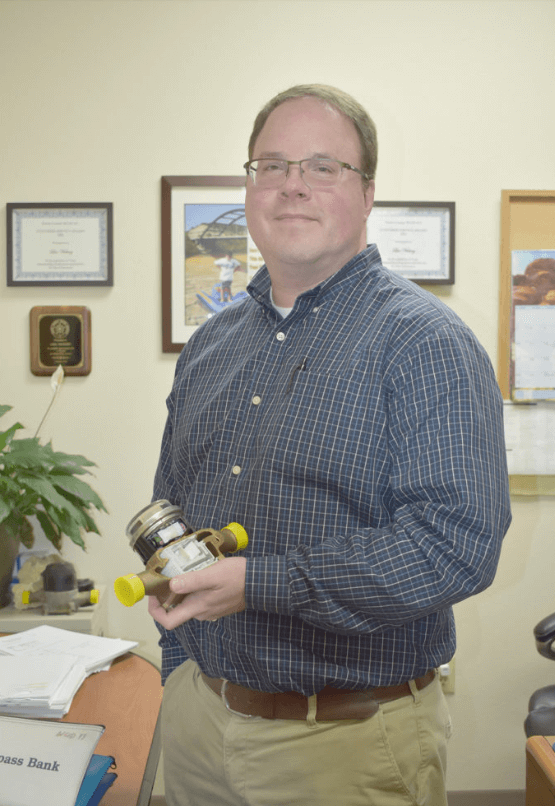
UPDATED Oct. 10, 2019
Follow up questions to WCID 17 general manager Jason Homan
Q: How do high temperatures correlate with more water usage? Most irrigation systems are set at the same amount so in an average situation without a leak or wrong setting, the homeowner would use the same amount of water each time regardless of the high temps?
A: It does when customers get involved with their systems and manually add watering events or alter their watering duration to combat the heat. This can be easily detected when we review the graph data from a customer’s account. One such example that I worked with a customer on yesterday involved a separate ‘B’ cycle the individual turned on during the billing period. He did so on purpose in response to the heat but didn’t realize how much water two completely separate cycles might end up using.
Again some customers also can be positive about what they have set their irrigation controller to do, but when the data is reviewed it becomes obvious that someone adjusted the settings. Only after the data review was the homeowner able to talk with their spouse and find out that indeed adjustments to the system had been made without the first spouse being aware.
Q: Is there a sliding scale on payments when a homeowner reaches a certain amount, that the cost per gallon is higher?
A: There is a tiered billing system in place here at WCID17. This is a very common billing method for water usage across the entire country as it purposely rewards those that prioritize conservation of our water resources.
Water Rates: Each customer will be charged a Base Rate as determined by the size of the meter and a Volume Rate as determined by the actual water used.
Base Rate: (All Customers)
Meter Size Base Fee
5/8″ $17.00
3/4″ $20.00
1″ $22.00
1 1/2″ $33.00
2″ $50.00
3″ $75.00
4″ $179.90
6″ $359.90
8″ $575.90
Volume Rate – Residential
0 to 10,000 gallons = $2.10 per 1,000 gallons
10,001 to 15,000 gallons = $3.16 per 1,000 gallons
15,001 to 30,000 gallons = $4.73 per 1,000 gallons
30,001 to 50,000 gallons = $7.10 per 1,000gallons
50,001 to 100,000 gallons = $10.65 per 1,000 gallons
over 100,000 gallons = $15.98 per 1,000 gallons
Volume Rate – Commercial
0 to 50,000 gallons = $2.73 per 1,000 gallons
50,001 to 100,000 gallons = $3.83 per 1,000 gallons
over 100,000 gallons = $6.64 per 1,000 gallons
Q: Also, some people have commented that why not have the 35-day billing cycle in the dead of winter when watering is at an all time low?
A: There is a tiered billing system in place here at WCID17. This is a very common billing method for water usage across the entire country as it purposely rewards those that prioritize conservation of our water resources.
Water Rates: Each customer will be charged a Base Rate as determined by the size of the meter and a Volume Rate as determined by the actual water used.
Base Rate: (All Customers)
Meter Size Base Fee
5/8″ $17.00
3/4″ $20.00
1″ $22.00
1 1/2″ $33.00
2″ $50.00
3″ $75.00
4″ $179.90
6″ $359.90
8″ $575.90
Volume Rate – Residential
0 to 10,000 gallons = $2.10 per 1,000 gallons
10,001 to 15,000 gallons = $3.16 per 1,000 gallons
15,001 to 30,000 gallons = $4.73 per 1,000 gallons
30,001 to 50,000 gallons = $7.10 per 1,000gallons
50,001 to 100,000 gallons = $10.65 per 1,000 gallons
over 100,000 gallons = $15.98 per 1,000 gallons
Volume Rate – Commercial
0 to 50,000 gallons = $2.73 per 1,000 gallons
50,001 to 100,000 gallons = $3.83 per 1,000 gallons
over 100,000 gallons = $6.64 per 1,000 gallons
Q: Some people have commented that why not have the 35-day billing cycle in the dead of winter when watering is at an all time low?
A: During the winter months we track all wastewater customer’s water usage water usage as part of there wastewater averaging calculation. In order to bill our customers for the wastewater processing that takes place we have to do so using their water bill (what goes in – goes out so to speak) but to do so in the summer would be grossly unfair as most customer are irrigating heavily in the spring, summer and fall. So to make the process as fair as possible we take the customer’s winter month water usage (when they are usually not watering) and average those months together. Then we use that “winter average” to calculate their water bill year round. So as you can see having short billing months with low usage in the winter actually benefits the average customer all year round. Most customers are unaware of this process but it significantly lowers their wastewater bill each month.
This ultimately is a case of trying to help the customer every month at the expense of one longer water billing month. We do our utmost to ensure we are putting the customer first even when it can be hard to see for a new customer or one that may not understand the entire process.
ORIGINAL story posted Oct. 13, 2019

By LYNETTE HAALAND, Four Points News
Many residents in Steiner Ranch, Comanche Trail, River Ridge and Strawberry Hill have noticed their September water bill much higher than previous months. The hottest September on record in Austin, a 35-day billing cycle and excessive irrigation are the main factors contributing to higher water bills, according to Jason Homan, Travis County Water Control and Improvement District 17’s general manager.
“We’ve gotten a lot of calls,” Homan said. WCID 17 has gotten over 100 calls since the September bills came out a few days ago.
September bills were delivered at the end of September and actually were from data compiled from about Aug. 6 to Sept 10.
“We’ve had discussions with everyone who has called,” Homan said. By Oct. 2, he personally had reviewed 10 of those 100+ cases.
Excessive irrigation
The cases he reviewed so far involve “extremely excessive” lawn irrigation, he said.
The WCID 17 two-day a week watering restrictions started May 1 and ended on Sept. 30.
But in one case of a high water bill, a homeowner was unaware that every day in August except for two their irrigation system was running from 3 a.m. to 7 a.m. which was about 2,500 gallons during each four hour stretch.
Another case involved a homeowner who was watering from midnight to 7 a.m. during three days a week for a span and then running at 12-hour intervals twice a week for another stretch of time, he said.
“They used just over 150,000 gallons last month and already almost 60,000 gallons this month,” Homan said. “They were using 5,500 gallons every time they turned on the (irrigation) system.
They didn’t for a second know they were watering that much.”
Sometimes with occurrences like power outages, computer crashes or lightning strikes, irrigation systems revert back to “factory reset” and run more than a typical setting by a homeowner.
Long billing cycle
WCID 17 does its best to ensure that the majority of billing months are consistently 28-29 days in length but in order to accomplish this in a 365 day year, the district has three months that are 34 days in length and one that is 35 days in length. August billing was 28 days, while September was 35 days.
“This longer billing period combined with multiple extremely dry months is expected to result in a much higher than normal bill,” Homan said.
High temperatures
Another reason for the higher water bills has been the hot and dry weather.
“We’ve had the second hottest August and the hottest September in recorded history,” Homan said.
Process
He understands the frustrations customers are feeling. “They get the bill and they want an answer,” he said.
But each case is reviewed individually and takes several days to process. A technician is sent to the home to download the information stored on the meter computer, which can store up to 90 days of data. That information is then reviewed by hourly and daily usage, etc., and concerns are addressed.
“We review each one individually to give customers the attention and respect their account deserves,” Homan said.
WCID 17 welcomes customers to call to check their water usage at any time. For more information, go to www.wcid17.org


